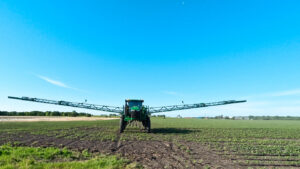Countless startups, VCs, and corporates are hard at work building the agri-foodtech ecosystem, but one startup is hoping to provide some much needed digital glue for the app-based offerings in the segment.
Describing itself as providing the industry’s “critically-needed infrastructure,” Leaf has developed an API intended to make it easy for anyone to seamlessly transfer data between hundreds of agriculture data sources through one simple integration. It raised an undisclosed pre-seed round in March 2019 from ACE Startups and Radicle Growth, according to Crunchbase.
Today, Brazil-born Leaf boasts an impressive list of major brand integrations including John Deere, AGCO, CNH, Climate, Trimble, Syngenta Strider, aWhere, New Holland, and over 50 public data sources.
This is the point where some of you may be inclined to open a new browser and type, “What is an API” into the search query. Let us save you some sleuthing:
“An API is essentially a programmatic way to access an app. It’s the way that apps talk to each other in the background,” Bailey Stockdale, CEO of Leaf, told AFN. “Really, every other industry has an infrastructure company: Plaid for fintech, Segment in marketing, for example. Without Plaid, Venmo would have to go to every bank in the US and obtain individual API configurations. Plaid does all those integrations and maintains them so Venmo doesn’t have to worry about them.”
The company recently came out of stealth mode after dedicating ample time to making sure that its products were robust enough to garner developer trust. Product readiness is key because if Leaf fails to provide the critical behind-the-scenes links between apps, farmers won’t be the only ones left frustrated; every business relying on Leaf will be left in the lurch. With a few big names on board, the company has so far been generating interest based on word-of-mouth.
For Leaf to succeed, the startup needed to obtain buy-in from as many tech providers and service providers as possible. If only a few companies agreed to let Leaf access their APIs, then it would hardly have enough traction to go the distance. The startup also has to make sure that as APIs are updated and new features added, the maintenance remains seamless. Leaf users don’t have to worry about its APIs changing — the startup does that for them.
“It wasn’t always easy. Sometimes we really had to leverage relationships to have people see how it benefits the entire ecosystem and eventually we got there and have buy-in. We started our focus on machine companies. Machine data is the cornerstone of a lot of analysis and applications, it’s also very difficult to work with.”
Leaf’s API is fully self-service, which means that developers can work with it quickly and easily. Virtually anyone can sign up for credentials on Leaf’s website and start using the APIs with the guidance of video tutorials. Smaller companies can be charged on a per-use basis, while larger companies have the option of paying an annual or monthly fee. Over the past six months, Leaf has seen a 40% month-over-month growth based on word-of-mouth promotion only.
Data siloing and a lack of interoperability among tech tools have been a farmer grievance for many years.
“Over the last 20 years or so, and even more recently, this was a huge concern regarding how companies saw data, especially machine companies. It’s what led to all those proprietary files and why it’s so hard to work with data from multiple sources. Everyone is trying to protect a proprietary format,” Stockdale explained.
Now, farmers have won the battle and companies are showing more willingness to engage in partnerships with the hopes of improving customer experience, he says. It’s more about bringing data together and building value on top of it than protecting secret sauces.
Stockdale doesn’t see any direct competition at the moment other than efforts from various associations like Ag Gateway to standardize data. He has heard of some efforts to give farmers the tools to internally manage data in a Dropbox-style system, which is a much different approach from Leaf. Moving forward, Stockdale sees challenges in figuring out where to focus Leaf’s efforts having already found use cases for its API across a variety of food and ag contexts like traditional agtech dashboards, marketplaces, and the potential to facilitate outcome-based pricing.
“Once the infrastructure is in place, it creates a surplus of new apps and new companies being made with new features that can offer end-users more options and choice,” he says. “We see that as where we want to get to. The ultimate vision is making digital ag work better and be more valuable and the way to get there is by empowering agtech developers at the ground level to build these products, including three people at a hackathon or someone at a Fortune 500 company.”
Check out Leaf’s tutorial and demo videos here:




